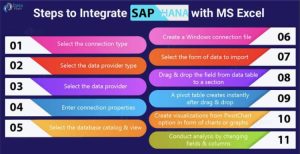With SAP HANA and Excel working together, businesses have access to cutting-edge tools for managing and analysing their data. Businesses can gain significant efficiencies in the reporting and analysis of data by combining SAP HANA, a premier in-memory database technology, with the ubiquitous Excel. There is no longer a requirement for time-consuming data extraction procedures thanks to real-time data access, which allows users to acquire and edit data straight from SAP HANA.
By combining the high-performance computing power of SAP HANA with Excel’s intuitive user interface, extensive formula library, as well as data-manipulation attributes, users can perform complex calculations and create insightful visualizations without leaving the Excel environment. The integration also improves reporting capabilities by opening the door to the development of interactive reports and dashboards based on real-time information.
Introduction
The requirement for efficient & seamless integration between data management systems & productivity tools is especially pressing in today’s fast-paced business environment. SAP HANA’s capacity to process large data sets and provide near-real-time insights have contributed to the platform’s meteoric rise in popularity.
SAP HANA’s compatibility with Microsoft Excel, the industry-standard spreadsheet program, expands the scope of possible reporting and analyzing data tasks. With SAP HANA & Excel working together, users can take advantage of the analytical power of SAP HANA while still working inside the comfort of Excel’s well-known interface. In this post, we discuss how integrating SAP HANA with Microsoft Excel may help businesses speed their data analysis processes, improve decision-making, and accelerate growth.
Companies in today’s data-driven economy have the ongoing issue of handling and making sense of massive amounts of data. With its powerful in-memory computing & sophisticated data-processing features, SAP HANA has quickly become a frontrunner among available options. Combining the power of SAP HANA’s database management system with the familiarity of Microsoft Excel’s analytical and reporting capabilities creates a smooth bridge between enterprise-grade data management and user-friendly interfaces.
 SAP HANA Integration with Microsoft Excel
SAP HANA Integration with Microsoft Excel
What is SAP HANA Integration?
SAP HANA Integration is the procedure of integrating the robust in-memory database platform SAP HANA with other software or hardware. Integrating SAP HANA with other systems improves the speed, accuracy, and completeness of data management, analysis, & reporting.
Depending on the needs & systems at play, SAP HANA integration can be accomplished with several different approaches and technologies. Common methods of integration include:
APIs, or Application Programming Interfaces:
SAP HANA offers a set of application programming interfaces (APIs) that enable programmers to retrieve, insert, and update data in the database. API integration with SAP HANA allows third-party programs to read from and write to the database.
Duplicate and Synchronized Data:
SAP HANA integration may entail data replication and synchronisation with third-party systems. This allows for real-time or near-real-time availability of data by ensuring that data is consistent and up-to-date across all platforms.
ETL Procedures: Extract, Transform, and Load
To load data into SAP HANA for reporting and analysis, ETL operations must first extract data from its sources before transforming it into an appropriate format. To guarantee data consistency and expedite data analysis in SAP HANA, integration with ETL tools allows for the smooth transfer of data from external systems through SAP HANA.
Integration with analytics tools and business intelligence (BI):
Integrating SAP HANA with other BI & analytics tools improves the platform’s capacity for analyzing and reporting on data. Users can take advantage of SAP HANA’s robust storage and processing of data capabilities, as well as the external apps’ sophisticated features and visualizations, through seamless integration with those tools.
ERP (Enterprise Resource Planning) Systems for Integration
Integrating SAP HANA with SAP ERP allows for streamlined data sharing and business process management. By integrating with ERP systems, SAP HANA guarantees that data from a wide range of business processes, including accounting, sales, and logistics, is immediately available for reporting and analysis.
SAP HANA connection is vital since it lets businesses use their data to its fullest potential. It paves the way for cutting-edge analytics, cross-platform collaboration, and near-real-time data access. Businesses in today’s data-driven market can improve decisio-making, and innovation, & gain a competitive edge by connecting SAP HANA with other systems and tools.
What is SAP?
Systems, Applications, & Products in Data Processing (SAP) is a multinational corporation that specializes in business application software for companies of all sizes as well as a variety of sectors. Since its inception in 1972, software giant SAP has expanded to become a trusted partner for millions of businesses worldwide.
SAP provides a suite of software that manages many aspects of a company’s operations, from human resources and accounting to supply chain management & customer relationship management. The goals of these programs are to facilitate data-driven decisio-making, increase operational efficiency, & streamline and automate corporate operations.
SAP’s capacity to link and integrate with other applications and systems within an organization, creating a unified picture of data and easing the flow of information, is one of its greatest features. The ability to integrate data helps companies eliminate information silos, boost cooperation, and gain a bird’s-eye view of their operations.
SAP ERP (Enterprise Resource Planning) is the company’s flagship product, and it serves as a consolidated platform for managing essential business activities. When it comes to optimizing operations and generating growth, SAP ERP has you covered across the board, from accounting and finance to production and distribution.
In addition to its flagship enterprise resource planning (ERP) software, SAP also provides a plethora of complementary software solutions, such as SAP SuccessFactors for human resource management, SAP Ariba for buying and selling chain management, SAP Customer Experience for sales and marketing, as well as SAP Analytics Cloud for business intelligence and analytics.
To gain complete knowledge about Database Management & Administration SAP HANA Online Training helps to a great extent.
 SAP HANA Integration with Microsoft Excel
SAP HANA Integration with Microsoft Excel
Image source: google
SAP HANA Integration with Microsoft Excel
Organizations can benefit greatly from the synergy between SAP HANA and Excel, two industry leaders in data management and analysis. Integrating SAP HANA, an outstanding performance in-memory database platform, with Microsoft Excel, one of the greatest popular productivity applications, improves the latter’s reporting and analysis of data features.
By integrating with Excel, customers can take advantage of Excel’s well-known interface and powerful features while also taking advantage of SAP HANA’s speed and capability for data storage and processing. This integration provides users the ability to conduct sophisticated data analysis, design interactive reports and dashboards, and make data-driven choices without leaving the Excel interface.
SAP HANA connection with Excel’s real-time data access is a major benefit. Users can bypass time-consuming manual data extraction by connecting directly to SAP HANA, guaranteeing that analysis depends on the most recent data available. Users gain an advantage over the competition thanks to the timely insights and quick decisions made possible by this access to data in real time.
The interface makes it possible to use SAP HANA’s sophisticated analytics features directly from within Excel. With Excel’s rich set of formulas and data manipulation tools, users can tap into SAP HANA’s high-performance computing capability to do elaborate computations, create detailed models of data, and conduct predictive analyses. By working together, SAP HANA & Excel help users gain a more nuanced understanding of their data.
Integrating SAP HANA with Excel also improves reporting capabilities. By combining the speedy data retrieval features of SAP HANA with the flexibility of Excel’s formatting tools, users may create reports that are both thorough and aesthetically pleasing. Changes done in the SAP HANA database appear quickly in Excel with this integration, allowing for dynamic reporting that is always correct and up-to-date.
The integration also makes it easier to work together and share information. Excel workbooks with SAP HANA data may be quickly and easily shared between users, facilitating cross-functional decision making and teamwork. The integration also includes data refresh features, which enable users to quickly update the data within Excel with the touch of a button.
Integration between SAP HANA and Excel goes beyond basic data manipulation. Use it to do things like aggregate data from many sources, do complex analytics, and connect to other SAP products. By combining these resources, businesses will have a more robust ecosystem in which to do data analysis, generate reports, and visualize their findings on SAP HANA.
In conclusion, the combination of SAP HANA with Microsoft Excel provides businesses with a robust environment in which to do data analysis and generate reports. Users can achieve a competitive edge in the digital age by maximizing the potential of their data through the combination of SAP HANA’s sophisticated capacity for data management with Excel’s intuitive interface & comprehensive functionality.
Conclusion
Integrating SAP HANA and Excel combines two powerful platforms into one, making it easier to analyze and report on data. An organization’s users are able to make well-informed decisions according to the most up-to-date information thanks to SAP HANA’s role as the database’s underpinning. This reduces inefficiencies caused by the requirement to manually extract data and update it.
By combining SAP HANA with Excel, businesses can take advantage of the best features of each system for more accurate reporting and analysis of data. This connection provides a comprehensive method for making decisions based on data by facilitating real-time data access, enhanced analytics, seamless collaboration, and connectivity with other SAP systems. Integrating SAP HANA with Excel allows businesses to boost productivity, improve decision-making, and maximize the value of their data resources.
Author Bio
Meravath Raju is a Digital Marketer, and a passionate writer, who is working with MindMajix, a top global online training provider. He also holds in-depth knowledge of IT and demanding technologies such as Business Intelligence, Salesforce, Cybersecurity, Software Testing, QA, Data analytics, Project Management and ERP tools, etc.

Related